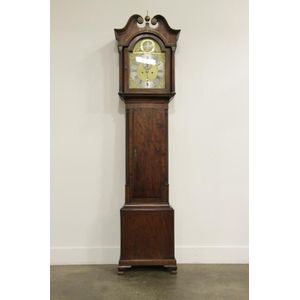Oak & Mahogany Longcase Clock with Shipping Scene Dial
You must be a subscriber, and be logged in to view price and dealer details.
Subscribe Now to view actual auction price for this item
When you subscribe, you have the option of setting the currency in which to display prices to $Au, $US, $NZ or Stg.
- Spandrel - An architectural term that in horology refers to the triangular ornamental decoration in the corners of of the dial plate. The spandrels are usually of cast brass and may be additonally chased and engraved. On painted dial clocks the spandrels are also usually painted.
- Mahogany - Mahogany is a dense, close grained red-coloured timber from the West Indies and Central America. It was first imported into Europe in the the early 18th century and its use continued through the 19th century. It was popular for furniture making because of its strength, the wide boards available, the distinctive grain on some boards, termed flame mahogany and the rich warm colour of the timber when it was polished.. The "flame" was produced where a limb grew out from the trunk of the tree, and this timber was usually sliced into veneers for feature panels on doors, backs and cornices.
Some terms used to describe mahogany relate to the country from which it originally came, such as "Cuban" mahogany, "Honduras" mahogany etc. However unless the wood has been tested the names assigned are more a selling feature, rather than a true indication of the timber's origin. - Oak - Native to Europe and England, oak has been used for joinery, furniture and building since the beginning of the medieval civilisation. It is a pale yellow in colour when freshly cut and darkens with age to a mid brown colour.
Oak as a furniture timber was superceded by walnut in the 17th century, and in the 18th century by mahogany,
Semi-fossilised bog oak is black in colour, and is found in peat bogs where the trees have fallen and been preserved from decay by the bog. It is used for jewellery and small carved trinkets.
Pollard oak is taken from an oak that has been regularly pollarded, that is the upper branches have been removed at the top of the trunk, result that new branches would appear, and over time the top would become ball-like. . When harvested and sawn, the timber displays a continuous surface of knotty circles. The timber was scarce and expensive and was used in more expensive pieces of furniture in the Regency and Victorian periods.
This item has been included into following indexes:
Visually similar items

A fine inlaid long case mahogany moon phase clock, early 19th century, marked Osborne to rear of dial, clock face manufacturers, with an arched broken pediment, engraved brass and spandrel decorated dial with a brushed steel chapter ring and Roman numerals

A Georgian oak and mahogany cased arch brass dial and painted panel grandfather clock. Maker: John Laurence of Lancaster. 231 cm high, 50 cm wide, 25 cm deep.

George III longcase clock the swan neck pediment with bird and orb finial, arched painted enamel dial with Roman and arabic numerals, subsidiary second and calendar dials in an inlaid mahogany case

An early 19th century mahogany cased grandfather clock the brass dial with a silvered chapter ring signed Geo. Bruce London. Height 218 cm. Width 45 cm. Depth 22 cm
